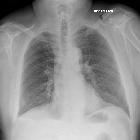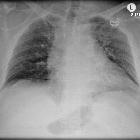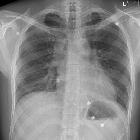chest radiograph






The chest radiograph (also known as the chest x-ray or CXR) is anecdotally thought to be the most frequently-performed radiological investigation globally although no published data is known to corroborate this. UK government statistical data from the NHS in England and Wales shows that the chest radiograph remains consistently the most frequently requested imaging test by GPs (2019 dataset) .
For pediatric chest radiograph see: chest radiograph (pediatric)
Indications
The chest radiograph is performed for a broad content of indications, including but not limited to :
- respiratory disease
- cardiac disease
- hemoptysis
- suspected pulmonary embolism
- investigation of tuberculosis
- pneumonia
- pneumothorax
- suspected metastasis
- follow up of known disease to assess progress
- chronic dyspnea
- trauma
- pneumoperitoneum
- evaluation of symptoms that could relate to abdominopelvic pathology
- thoracic disease processes
- monitoring of patients in intensive care units
- post-operative imaging
- pre-employment medical fitness
- immigration screening
- check position of nasogastric tubes, endotracheal tubes, PICCs etc.
- exclude radiopaque foreign bodies (accidental aspiration, MRI safety screen)
Projections
PA projection
- the posteroanterior (PA) view is the standard frontal chest projection
- the x-ray beam traverses the patient from posterior to anterior
- it is performed standing and in full inspiration with the patient hugging the detector to pull the scapulae laterally
- it is the best general radiographic technique to examine the lungs, bony thoracic cavity, mediastinum and great vessels
- advantages: technically excellent visualization of the mediastinum and lungs, with accurate assessment of heart size
- disadvantages: patient must be able to stand erect
AP projection
- the anteroposterior (AP) erect view is an alternative frontal projection to the PA projection with the beam traversing the patient from anterior to posterior
- it can be performed with the patient sitting up on the bed and even performed outside the radiology department using a mobile x-ray unit
- advantages: more convenient for intubated and sick patients who will not be able to stand for a PA projection
- disadvantages: mediastinal structures may appear magnified as the heart is further away from the detector, often poorly inspired, more likely to be rotated and to create skin folds, scapulae often cover some of the lungs
- a AP supine view is a further alternative frontal projection technique often used in trauma patients, or patients who can't sit up
- the supine position results in physiological widening of the cardiomediastinal outline including superior mediastinum, as well as congestion of the pulmonary veins with upper lobe venous diversion
Lateral projection
- the lateral view of the chest is performed erect left lateral and labeled with the side closest to the cassette
- a paravertebral gutter technique involves rotating the right side 5-10° anterior (RAO) to align the posterior ribs along the divergent beam
- it allows for localization of suspected chest pathology when assessed in conjunction with a PA view
- examines the retrosternal and retrocardiac spaces
- it allows assessment of the posterior costophrenic recesses
- salient points
- gastric bubble is under the left hemidiaphragm; left hemidiaphragm is less distinct anteriorly due to the cardiac silhouette
- right hemidiaphragm appears higher and more complete (as the right is closer to the beam)
- the radiation dose from a lateral chest radiograph is substantially higher than that of a PA projection and should probably not be routinely performed for this reason
Additional projections
Other forms of the chest radiographs are performed in a variety of clinical scenarios:
- lateral decubitus
- the patient is laying either left lateral or right lateral on a trolley on top of a radiolucent sponge.
- the detector is placed landscape posterior to the patient running parallel with the long axis of the thorax.
- the patient’s hands should be raised to avoid superimposing on the region of interest, legs may be flexed for balance.
- problem-solving film, used to differentiate pneumothorax vs. pleural effusion; pneumothorax vs. pneumomediastinum.
- air trapping due to inhaled foreign bodies and showing and quantifying pleural effusions
- expiration view
- for pneumothorax and air trapping due to inhaled foreign bodies
- lordotic view
- demonstrates areas of the lung apices that appear obscured on the PA/AP chest radiographic views
- right anterior oblique (RAO)/left anterior oblique (LAO) view
- for rib fractures and intrathoracic lesions (RAO also used routinely used in barium esophagography)
- ribs AP view
- for suspected posterior rib fractures
- ribs PA view
- for suspected anterior rib fractures
- sternum lateral view
- a lateral projection often used to query fractures or infection
- sternum oblique view
- an RAO projection that is orthogonal to the lateral sternum view
Pitfalls
- rotation of the frontal projection can markedly affect the appearance of the CXR
- apparent mediastinal widening
- tracheal deviation
- apparent increased thickness of the paratracheal stripes
- asymmetric lung density
- supine positioning of the patient will alter the appearance of the CXR
- enlarge the heart (cardiothoracic ratio)
- alter the appearance of fluid or gas in the pleural space
- pneumothorax
- pleural effusion
- alter the appearance of fluid in the lung air spaces
- upper lobe vascular redistribution
- alveolar fluid distribution
- skin folds on AP projections may mimic visceral pleural sign of pneumothorax
- think twice before labeling dextrocardia as there exist processing errors; correlate with stomach bubble
Patient preparation
The patient should be asked to remove all clothing and jewelry from the waist up and dress in a hospital gown. Long hair should be worn up.
Tubings and lines must be removed from field of view in ward radiography.
Siehe auch:
- Artefakte im Röntgenbild des Thorax
- Normale Herzkonfiguration im Röntgen-Thorax
- chest radiograph zones
- normal position of diaphragms on chest radiography
- Röntgen Thorax Normalbefund
- Thorax Onlinekurs
- chest radiograph classification of pulmonary sarcoidosis
- chest radiograph in the exam setting
- differential of enlarged pulmonary trunk on chest radiography
und weiter:
- Herzkonfiguration
- Aorta ascendens
- right upper lobe apical segment
- pulmonary opacification
- reticular and linear pulmonary opacification
- apical zone
- cardiac curriculum
- posterior mediastinal mass in the exam
- Thorax
- nodular opacification
- Lungenlappen
- Artefakte im Röntgenbild
- adult chest radiograph pathology checklist
- cardiomediastinal outlines on chest x-ray
- normal lordotic chest radiograph

 Assoziationen und Differentialdiagnosen zu Röntgen-Thorax:
Assoziationen und Differentialdiagnosen zu Röntgen-Thorax:



